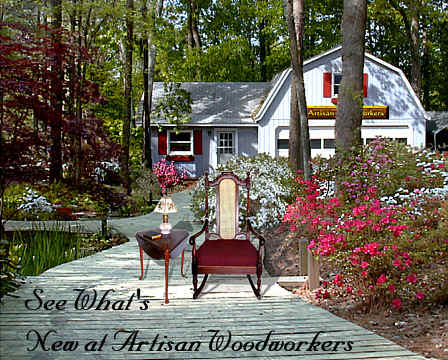

Glossary of Terms,
Antique Furniture
B
Bachelor's Chest: A small-scaled chest of drawers designed to house small items of male apparel.
Bail: Metal reverse arch handle or drawer pull that hangs downward from pins attached to a backplate.
Ball-and-claw: A carved foot found mostly on Chippendale designs. It is a form of ornament originating in China, and is supposed to represent a bird's claw grasping an egg.
Ball foot: A turned foot for chests or chest of drawers, usually quite large in diamenter, and found on early styles.
Balloon-back: Chair style developed by Hepplewhite having an open hoop-style back.
Bamboo: The wood of the Bamboo tree is used for furniture in the East, and came to the Occident in various waves of Chinese influences. In the 18th Century it was so important that the characteristic appearance of the bamboo was simulated in the wood turnings in England and America.
Banding: A narrow strip of the contrasting inlay, framing drawer fronts, table tops, etc.
Baroque: A fantastic style of the 16th Century to the mid-18th Century marked by exaggerated scale, curves, and movement, and was always symmetrical.
Bas Relief: Carving projecting only slightly from background. Same as low relief.
Batten: Strips of wood used as a brace or cleat across one or more boards.
Bauhaus: German school of art, industrial design, and architecture founded by Walter Gropius in Weimar in 1919. Probably the first exponent of "total design", it held to the philosophy that there should be a melding of all the arts...a marriage of arts and architecture with modern technology. Opposed to "art for art's sake" the Bauhaus subscibed to an honest expression of modern technology in the implements of daily living.
Bead: a narrow half-round convex moulding, its surface being flush with the adjacent surface, or raised above it.
Bead and Reel: A carved molding of Classical origin, the ordinary bead is interupted at regular intervals.
Bed-Bolt cover: A small brass ornamant used to cover the head of a bed bolt.
Bergere: A French armchair with closed upholstered sides and back.
Bevel: A sloping edge, planed or chiseled on the edge of any surface.
Biedermeier: Rustin German version of the French Empire. Name derives from popular comic character of the time, Papa Biedermeier, symbol of homey comfort.
Birdseye: Mottled figure wood grain suggesting a bird's eye; mainly seen in maple.
Blanket Chest: Low storage chest with hinged lid and often a lower drawer; serving also as bench.
Block Front: A term applied to the unique type of construction for fronts of Early American chest of drawers and chest-on-chests; consisting of a concave, but fattened, recession at the center, and two convex, but flattened, swells on the ends. It is a type of construction supposed to have originated with John Goddard, a famous cabinetmaker in Newport, RI.
Bombe: An outward-swelling kettle-base construction for chests of drawers and secretaries, found on the Chippendale and Louis XV styles.
Bonnet top: An unbroken pediment or top section of a highboy, secretary and the like; also Hooded top.
Bookcase Headboard: A headboard with built-in storage for books, radios, reading lights, etc. A modern form which has been given period interpretations.
Borax: Term applied to cheap, bulky, flashy, poorly-constructed furniture, generally sold on time payment plans. Name believed to have derived from the fact that such furniture was once obtainable through premiums given with a well-known borax cleaning compound.
Boss: Round or oval ornament after Gothic sources common in the 17th Century English and American work, particularly on chests. Usually half turning painted black.
Boston Rocker: Rocking chair, American 19th Century, with wood seat curved upwards, wide scrolled top rail and delicate spindles. Usually painted with fine ornamental detail.
Bow Back: Windsor chair back in which the bow or hoop is continuous either down to the arms or the seat.
Bow front: Convex shaped front of a chest, buffet, etc., characteristic of 18th Century work.
Bracket Foot: Simple base on chests and case furniture of the 18th Century. The foot runs two ways from the corner, in more or less simple shapes. The type was highly ornamented by Chippendale in England, by Goddard and others in America.
Breakfront: A bookcase or china cabinet with a center section projecting forward from the two end sections. In bookcases, lower part of center section often contains a desk.
British Colonial: Style developed by the British colonists in the West Indies during the late 18th and 19th Centuries. Consistently simple and reminiscent of the late Georgian work, it exhibits local influences in appropriate planning and materials.
Brocade: Heavy, rich fabric woven with raised pattern resembling embroidery. Used for upholstery; sometimes drapery.
Broken Pediment: Pediment, straight, swan neck or goose neck, the side lines or scrolls of which do not meet at the apex.
Buffet: French term referring to sideboard used to store china, silver, and linens. Top surface used as a counter in self-service informal dining.
Bun Foot: A slightly flattened ball foot, Dutch in origin.
Bunk bed: Twin beds mounted one above the other; sometimes detachable for use separately.
Bureau: Low chest of drawers, generally used in bedroom with mirror. Originally a writing desk or table with drawers.
Burl: A figured veneer secured from a tree at a place where an abnormal growth of some kind has produced a figure of unusual beauty in the grain.
Butterfly Hinge: A hinge made of iron and resembling a butterfly. It is found on Early American furniture.
Butterfly table: An Early American drop-leaf table, generally small, leaves of which are supported by swinging brackets suggesting butterfly wings.
Butterfly Wedge: Cleat, shaped like wings of a butterfly, used to fasten to fasten adjoining boards.
Butt Hinge: A square or rectangle hinge of brass or iron, the two leaves are connected by a pin.
Butt Joint: The term refers to a joint on which the squared end of the one member is butted against the side or the end of another member.
